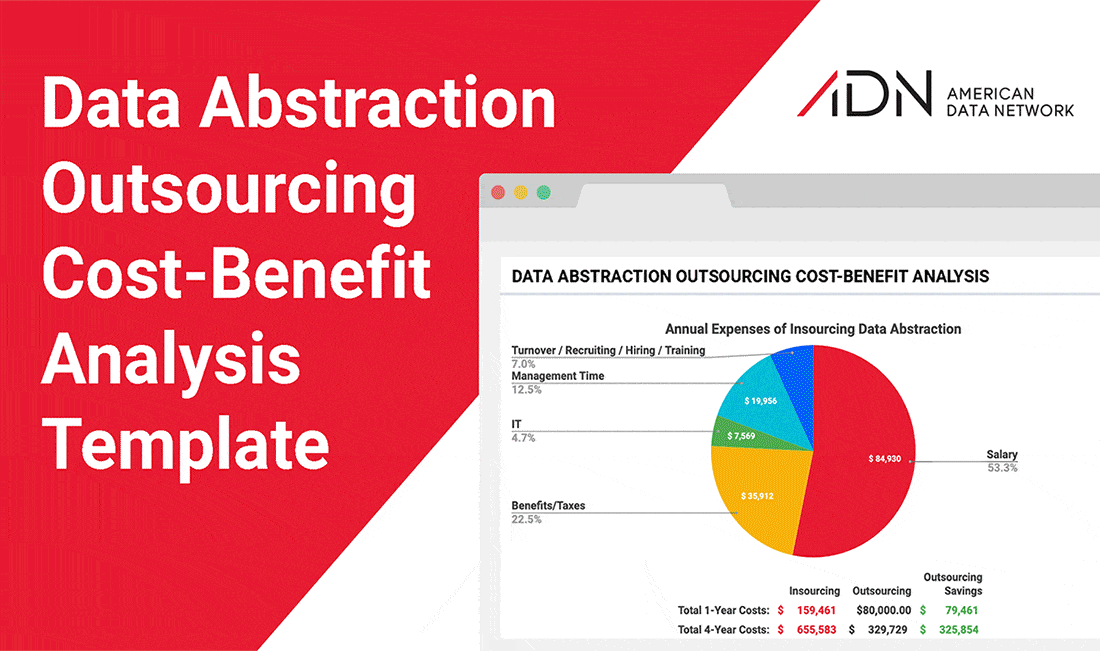Table of Contents
- Determine the True Costs of In-House Data Abstraction
- Factor in Turnover and Soft Costs
- Tailor the Cost-Benefit Analysis to Your Facility
- Visualize Your Savings with Customizable Reports
- Make Data-Driven Decisions with Confidence
Reallocating data abstraction staff and outsourcing these positions can significantly reduce hospital expenses. American Data Network’s Outsourcing Cost-Benefit Analysis Template helps hospital leaders evaluate the true costs associated with in-house data abstraction versus outsourcing. This tool, designed for quick and precise results, provides valuable insights into potential savings by using real data and expert resources.
Determine the True Costs of In-House Data Abstraction
The first step in creating an accurate cost-benefit analysis for outsourcing data abstraction is calculating the actual costs of maintaining an in-house team. It’s important to recognize that the costs go beyond just salaries. Employee benefits, taxes, and additional expenses, such as IT infrastructure and management time, need to be factored in. Data shows that the real cost per employee, including benefits and taxes, can range from 125% to 140% of their salary. Additionally, facilities often overlook costs tied to recruiting, turnover, and training – critical factors that can substantially increase overall expenditures.
If you’re considering the potential objections to outsourcing data abstraction, American Data Network offers resources that address common concerns and misconceptions.

Factor in Turnover and Soft Costs
Turnover rates in hospitals can reach up to 21% annually. This analysis projects costs over a five-year period to account for the likelihood of staff changes. These totals include both hard costs, like salaries and IT expenses, and soft costs, such as the time a quality manager spends on overseeing recruitment and training. Facilities can also enter specific overhead costs unique to their organization into the template. Unknown costs related to employee management are included as well. By contrast, outsourcing offers predictable budgeting with no hidden costs, making financial planning straightforward and reliable.
Understanding the opportunity cost in healthcare is crucial when evaluating whether to maintain an in-house team or outsource data abstraction.
Tailor the Cost-Benefit Analysis to Your Facility
American Data Network’s template guides users through customizing the tool for their hospital’s specific needs. It incorporates state-specific data from the Bureau of Labor Statistics for employee benefits and other expenses. By inputting the number of data abstractors on your team, their salaries, and management time, you can calculate a precise cost structure. This personalization helps ensure that the analysis reflects the actual financial impact of data abstraction at your facility.

For hospitals looking to enhance efficiency, explore how the concept of ‘smartsourcing’ data abstraction can offer significant advantages beyond just cost savings.
Visualize Your Savings with Customizable Reports
The template provides both a table view and a graphical representation of costs and potential savings over four years, making it easy to share findings with hospital leadership. These visuals enable quick and effective decision-making, ensuring stakeholders have a clear picture of the potential benefits of outsourcing.
To further understand the financial benefits, explore the ROI of outsourcing for your data abstraction needs.
Make Data-Driven Decisions with Confidence
By using ADN’s Outsourcing Cost-Benefit Analysis Template, hospitals can make informed, data-driven decisions about whether outsourcing data abstraction is a viable option. This tool simplifies the evaluation process, allowing healthcare facilities to optimize their resources and budget dollars more effectively.
For a step-by-step guide on using the Outsourcing Cost-Benefit Analysis Template, watch the video below. It walks you through the customization process and shows how to interpret the savings projections effectively.




